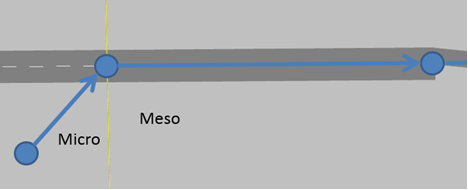
During dynamic assignment, you can use mesoscopic simulation to simulate your entire network. At the same time, you may also use microscopic simulation to simulate one or several areas of your Vissim network. This combination allows you to create a Vissim network of the size required for your particular use case and perform a detailed analysis for the results of the relevant network parts based on microscopic simulation.
To define the areas you want to simulate microscopically, you define sections (Modeling sections). You select these sections in the simulation parameters for mesoscopic simulation (Selecting sections for hybrid simulation). Within the sections, vehicles are moved according to the algorithms of microscopic simulation. The settings of mesoscopic simulation do not apply for these sections. For vehicles traversing between the two areas, the mesoscopic simulation settings continue to apply. Accordingly, properties such as the desired speed are kept.
Please note the information on how to define sections (Modeling sections). As the calculation basis for vehicle movement changes significantly at these transition areas, unrealistic vehicle behavior may occur, particularly if the edges are very short.
The following figure shows a schematic drawing of the transition area from micro- to mesoscopic simulation.

At the transition point, additional meso nodes and meso edges are created. For vehicles entering the meso area, the macroscopic speed specified for the first edge after transition is used. If this edge is very short, significant fluctuations occur that in turn impact vehicle inputs from the microscopic area. As a consequence, there might be unrealistically high wait times on the micro-meso transition edge, as vehicles are not able to leave it.
At the transition point from meso- to microscopic simulation, vehicles are introduced similarly to vehicle inputs. Here, too, you need to ensure that signal heads, desired speed decisions, reduced speed areas, etc. are not too close to the transition point, otherwise they might be ignored by the vehicles.
For a comprehensive analysis of the entire network, use the network performance and link evaluation (Vehicle network performance : Displaying network performance results (vehicles) in result lists), (Showing data from links in lists). You can record data using node evaluation (Evaluating nodes).
Superordinate topic:
Using add-on module for mesoscopic simulation
Related topics:
Car following model for mesoscopic simulation
Node control in mesoscopic simulation
Rules and examples for defining meso network nodes
Selecting sections for hybrid simulation
